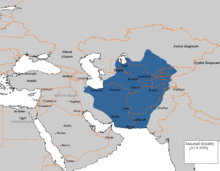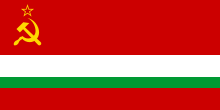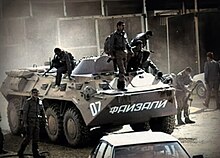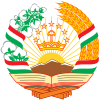History of Tajikistan
| History of Tajikistan |
|---|
| Timeline |
|
|
It has since experienced three changes in government and the Tajikistani Civil War. A peace agreement among rival factions was signed in 1997.
Antiquity (600 BC – 710 AD)


Tajikistan was bordered on the north by the
Tajikistan was part of the
Some authors have also suggested that in the 7th and 6th century BCE parts of modern Tajikistan, including territories in the Zeravshan valley, formed part of
Achaemenid Period (550 BC – 329 BC)
During the
Hellenistic Period (329 BC – 90 BC)
After the Achaemenid Empire was defeated by
Kushan Empire (30 BC – 410 AD)
For another 400 years, until 410 AD, the Kushan Empire was a major power in the region along with the
The Sassanids, Hephthalites, and Gokturks (224–710)

The Sassanids once controlled much of what is now Tajikistan, but lost the territory to the Hephthalites (possibly also of Iranian descent) during the time of Peroz I.
They created a powerful empire that succeeded in making
Medieval history (710–1506)
Arab Caliphate (710–867)

The Transoxiana principalities never formed a viable confederacy. Beginning in 651, the Arabs organized periodic marauding raids deep into the territory of Transoxania, but it was not until the appointment of Ibn Qutaiba as Governor of
Samanid Empire (819–999)

The
The attack of the Qarakhanid Turks ended the Samanid dynasty in 999 and dominance in Transoxiana passed on to Turkic rulers.
Qarakhanids (999–1211) and Khwarezmshahs (1211–1218)
After the collapse of Samanid Dynasty, Central Asia became the battleground of many Asian invaders who came from the north-east.
Mongol rule (1218–1370)
The
Timurid Empire (1370–1506)
Timur, founder of the Timurid Empire, was born on 8 April 1336 in Kesh near Samarkand. He was a member of the Turkicized Barlas tribe, a Mongol subgroup that had settled in Transoxiana after taking part in Genghis Khan's son Chagatai's campaigns in that region. Timur began his life as a bandit leader. During this period, he received an arrow-wound in the leg, as a result of which he was nicknamed Timur-e Lang (in Dari) or Timur the Lame. Although the last Timurid ruler of Herat, Badi az Zaman finally fell to the armies of the Uzbek Muhammad Shaibani Khan in 1506, the Timurid ruler of Ferghana, Zahir-ud-Din Babur, survived the collapse of the dynasty and re-established the Timurid dynasty in India in 1526 where they became known as the Mughals.
Early modern history (1506–1868)
Turkic rule (1506–1598)
The
The period of political expansion and economical prosperity was short-lived. Soon after the death of Abd Allah Khan the Shaibanid dynasty died out and was replaced by the Janid or Astrakhanid (Ashtarkhanid) dynasty, another branch of the descendants of Jöchi, whose founder Jani Khan was related to Abd Allah Khan Through his marriage to Abdullah Khan's Sister. The Astrakhanids are also said to be connected to the Hashemites due to Imam Quli Khan's status as a Sayyid. Their descendants today live in India. In 1709, eastern part of Khanate of Bukhara seceded and formed Khanate of Kokand. Thus, the eastern part of present Tajikistan passed to the Khanate of Kokand, while the western one remained part of the Khanate of Bukhara.
Iranian and Bukharan rule (1740–1868)
In 1740, the Janid khanate was conquered by Nader Shah, the Afsharid ruler of Iran. The Janid khan Abu al Faiz retained his throne, becoming Nadir's vassal.
After the death of Nader Shah in 1747, the chief of the
Modern History (1868–1991)
Russian Vassalage (1868–1920)

Russian

The expansion was motivated by Russia's economic interests and was connected with the American Civil War in the early 1860s, which severely interrupted the supply of cotton fiber to the Russian industry and forced Russia to turn to Central Asia as an alternative source of cotton supply as well as a market for Russian made goods. The Russian regime in the 1870s attempted to switch cultivation in the region from grain to cotton (a strategy later copied and expanded by the Soviets).[10] By 1885 Tajikistan's territory was either ruled by the Russian Empire or its vassal state, the Emirate of Bukhara, nevertheless Tajiks felt little Russian influence.[10]
Russian Empire, being a much bigger state with a huge population and having an advanced military, had little difficulty in conquering the regions inhabited by Tajiks, meeting fierce resistance only at
During the late 19th century the Jadidists established themselves as an Islamic social movement throughout the region. Although the Jadidists were pro-modernization and not necessarily anti-Russian the Russians viewed the movement as a threat.[11] Russian troops were required to restore order during uprisings against the Khanate of Kokand between 1910 and 1913. Further violence occurred in July 1916 when demonstrators attacked Russian soldiers in Khujand over the threat of forced conscription during World War I. Despite Russian troops quickly bringing Khujand back under control, clashes continued throughout the year in various locations in Tajikistan.[10]
At the end of August 1920 the last emir, Sayyid Alim Khan, was overthrown by Soviet troops. On 6 October 1920 the emirate was abolished and the Bukharan People's Soviet Republic was proclaimed.
Basmachi movement (1916-1924)
The Basmachi movement or Basmachi Revolt was an uprising against Russian Imperial and Soviet rule that arose after the Russian Revolution of 1917 guerrillas throughout Central Asia.
The movement's roots lay in the anti-conscription violence of 1916 that erupted when the Russian Empire began to draft Muslims for army service during
The fortunes of the decentralized movement fluctuated throughout the early 1920s but by 1923 the Red Army's extensive campaigns dealt the Basmachis many defeats. After major Red Army campaigns and concessions regarding economic and Islamic practices in the mid-1920s, the military fortunes and popular support of the Basmachi declined.[15] Resistance to Soviet/Russian rule did flare up again to a lesser extent in response to collectivization campaigns in the pre-WWII Era.[16]
Soviet Rule (1920–1991)

In 1924, the
Between 1927 and 1934
Two rounds of Soviet purges directed by Moscow (1927–1934 and 1937–1938) resulted in the expulsion of nearly 10,000 people, from all levels of the Communist Party of Tajikistan.[18] Ethnic Russians were sent in to replace those expelled and subsequently Russians dominated party positions at all levels, including the top position of first secretary.[18] Between 1926 and 1959 the proportion of Russians among Tajikistan's population grew from less than 1% to 13%.[19] Bobojon Ghafurov, Tajikistan's First Secretary of the Communist Party of Tajikistan from 1946 to 1956 was the only Tajikistani politician of significance outside the country during the Soviet Era.[14] He was followed in office by Tursun Uljabayev (1956–61), Jabbor Rasulov (1961–1982), and Rahmon Nabiyev (1982–1985, 1991–1992).
Tajiks began to be conscripted into the Soviet Army in 1939 and during
In the 1980s, Tajikistan had the lowest household saving rate in the USSR,[23] the lowest percentage of households in the two top per capita income groups,[24] and the lowest rate of university graduates per 1000 people.[25]

Living standards were undermined during the tenure of Kahar Mahkamov as first secretary of the Communist Party of Tajikistan from 1985. Mahkamov's attempted marketisation of the Tajik economy aggravated the poor living conditions and unemployment. On the eve of the Soviet collapse Tajikistan was suffering from a declining economy and dim prospects for recovery. The glasnost policy of openness initiated by Mikhail Gorbachev offered disgruntled Tajiks a chance to voice their grievances. In 1991, the Soviet Union collapsed, and Tajikistan declared its independence.
Republic of Tajikistan (1991–present)

The Tajikistan Soviet Socialist Republic (SSR) was among the last republics of the Soviet Union to declare its independence. On September 9 (1991), following the collapse of the Union of Soviet Socialist Republics (USSR), Tajikistan declared its independence. During this time, use of the Tajik language, an official language of the Tajikistan SSR next to Russian, was increasingly promoted. Ethnic Russians, who had held many governing posts, lost much of their influence and more Tajiks became politically active.
The nation almost immediately fell into a civil war that involved various factions fighting one another; these factions were often distinguished by clan loyalties. The non-Muslim population, particularly Russians and Jews, fled the country during this time because of persecution, increased poverty and better economic opportunities in the West or in other former Soviet republics.
Emomali Rahmon came to power in 1994, and continues to rule to this day. Ethnic cleansing was controversial during the civil war in Tajikistan. By the end of the war Tajikistan was in a state of complete devastation. The estimated dead numbered over 100,000. Around 1.2 million people were refugees inside and outside the country.[26] In 1997, a ceasefire was reached between Rahmon and opposition parties (United Tajik Opposition).
Peaceful elections were held in 1999, but they were reported by the opposition as unfair, and Rahmon was re-elected by almost unanimous vote. Russian troops were stationed in southern Tajikistan, in order to guard the border with Afghanistan, until summer 2005. Since the September 11, 2001 attacks, American, Indian and French troops have also been stationed in the country.
In October 2020, President Emomali Rahmon was re-elected for next seven-year period with 90 per cent of the votes, following a tightly controlled and largely ceremonial election.[27]
See also
- Guzel Maitdinova
- Dissolution of the Soviet Union
- History of Central Asia
- Politics of Tajikistan
- Soviet Central Asia
References
Footnotes
- from the original on 2023-01-24. Retrieved 2021-11-15.
- ^ a b The History of Tajik SSR, Maorif Publ. House, Dushanbe, 1983, Chapter V (in Russian).
- ^ See: The Deeds of Harsha: Being a Cultural Study of Bāṇa's Harshacharita, 1969, p 199, Dr Vasudeva Sharana Agrawala; Proceedings and Transactions of the All-India Oriental Conference, 1930, p 118, Dr J. C. Vidyalankara; Prācīna Kamboja, jana aura janapada =: Ancient Kamboja, people and country, 1981, Dr Jiyālāla Kāmboja, Dr Satyavrat Śāstrī – Kamboja (Pakistan).
- ^ Dr J. C. Vidyalankara, Proceedings and Transactions of 6th A.I.O. Conference, 1930, p 118; cf: Linguistic Survey of India, Vol X, pp 455-56, Dr G. A. Grierson.
- ISBN 978-1-4422-7616-1. Archivedfrom the original on 24 January 2023. Retrieved 13 July 2022.
- Muslimwriters (See: Studies in Indian History and Civilization, Agra, p 351; India and the World, 1964, p 71, Dr Buddha Prakash; India and Central Asia, 1955, p 35, P. C. Bagch).
- ISBN 0-521-24304-1
- ^ Soucek, Svat. A History of Inner Asia (2000), p. 180.
- ^ W. Fierman, "The Soviet 'transformation' of Central Asia", in: W. Fierman, ed., Soviet Central Asia, Westview Press, Boulder, CO, 1991.
- ^ a b c A Country Study: Tajikistan, Tajikistan under Russian Rule, Library of Congress Call Number DK851 .K34 1997, http://lcweb2.loc.gov/cgi-bin/query/r?frd/cstdy:@field%28DOCID+tj0013%29 Archived 2022-01-20 at the Wayback Machine
- ^ anti-Russian, tsarist officials in Turkestan found their kind of education even more threatening than traditional Islamic teaching, A Country Study: Tajikistan, Tajikistan under Russian Rule, Library of Congress Call Number DK851 .K34 1997, http://lcweb2.loc.gov/cgi-bin/query/r?frd/cstdy:@field%28DOCID+tj0013%29 Archived 2022-01-20 at the Wayback Machine
- ^ Victor Spolnikov, "Impact of Afghanistan's War on the Former Soviet Republics of Central Asia," in Hafeez Malik, ed, Central Asia: Its Strategic Importance and Future Prospects (New York: St. Martin's Press, 1994), 101.
- ISBN 1438105517
- ^ a b c d Post War Period, U.S. Library of Congress, http://countrystudies.us/tajikistan/11.htm Archived 2012-10-14 at the Wayback Machine
- ^ Michael Rywkin, Moscow's Muslim Challenge: Soviet Central Asia (Armonk: M. E. Sharpe, Inc, 1990), 41.
- ^ Martha B. Olcott, "The Basmachi or Freemen's Revolt in Turkestan, 1918-24," Soviet Studies, Vol. 33, No. 3 (Jul., 1981), 361.
- ^ a b Collectivization, U.S. Library of Congress, http://countrystudies.us/tajikistan/9.htm Archived 2012-10-14 at the Wayback Machine
- ^ a b The Purges, U.S. Library of Congress, Tajikistan Country study, 1996, http://countrystudies.us/tajikistan/10.htm Archived 2012-10-14 at the Wayback Machine
- ^ Tajikistan – Ethnic Groups Archived 2010-12-07 at the Wayback Machine, U.S. Library of Congress
- ^ Historical Dictionary of Tajikistan, by Kamoludin Abdullaev, Shahram Akbarzaheh, 2010, second edition, pg 383
- ISBN 5-93165-107-1, pp. 23–35
- ^ Tajikistan, viewed 2014, http://ww2db.com/country/tajikistan Archived 2014-07-26 at the Wayback Machine
- ^ Boris Rumer, Soviet Central Asia: A Tragic Experiment, Unwin Hyman, London, 1989, p. 126.
- ^ Statistical Yearbook of the USSR 1990, Goskomstat, Moscow, 1991, p. 115 (in Russian).
- ^ Statistical Yearbook of the USSR 1990, Goskomstat, Moscow, 1991, p. 210 (in Russian).
- ^ Tajikistan: rising from the ashes of civil war Archived 2009-08-18 at the Wayback Machine. United Nations
- ^ "Tajikistan re-elects leader Rahmon with overwhelming majority". Archived from the original on 2020-11-20. Retrieved 2021-05-03.
Sources and further reading
- Asimov, M.S. Tadzhikskaya Sovetskaya Sotsialisticheskaya Respublika(The Tajik Soviet Socialist Republic). (Dushanbe: Akademiya Nauk Tadzhikskoy SSR) 1974.
- Barthold, V.V. Работы по Исторической Географии (Moscow) 2002.
- Barthold, V.V. Turkestan Down to the Mongol Invasion (London: Luzacs & Co) 1968.
- Becker, Seymour. Russia’s Protectorates in Central Asia: Bukhara and Khiva, 1865-1924 (Cambridge, Mass.: Harvard University Press) 1968.
- Curzon Press) 1997.
- Carrère D’Encausse, Hélène. Islam and the Russian Empire: Reform and Revolution in Central Asia (London: I.B. Tauris) 1988.
- Christian, David. A History of Russia, Central Asia and Mongolia (Oxford: Blackwell) 1998.
- Hiro, Dilip. Between Marx and Muhammad (London:HarperCollins) 1995.
- Kapur, Harish. Soviet Russia and Asia, 1917–1927, a study of Soviet policy towards Turkey, Iran and Afghanistan (London: Joseph for the Geneva Graduate Institute of International Studies) 1966.
- Luknitsky, Pavel. Soviet Tajikistan (Moscow: Foreign Languages Publishing House) 1954.
- Masov, Rahim. The History of a National Catastrophe (Minneapolis) 1996. Available on-line here
- Pipes, Richard. The Formation of the Soviet Union, Communism and Nationalism 1917-1923 (Cambridge, Mass.: Harvard University Press) 1964.
- Orient Longman) 2002.
- Rawlinson, H.G. Bactria : The History of a Forgotten Empire (New Delhi: Asian Educational Services) 2002.
- Weidenfeld and Nicolson) 1964.
- Soucek, Svat. A History of Inner Asia (Cambridge University Press) 2000.
- Zenkovsky, Serge A. Pan-Turkism & Islam in Russia (Harvard University Press) 1960.
Further reading
- Poopak NikTalab. Sarve Samarghand (Cedar of Samarkand), continuous interpretation of Rudaki's poems, Tehran 2020, Faradid Publications {Introduction

